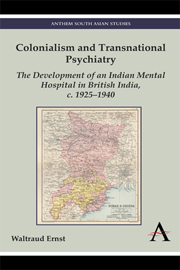 Colonialism and Transnational Psychiatry
Colonialism and Transnational Psychiatry This book focuses on the Ranchi Indian Mental Hospital, the largest public psychiatric facility in colonial India during the 1920s and 1930s. Although it does not cover the views of the patients and their families, its scope is wide-ranging in other respects and it breaks new ground in the fields of history of colonial medicine in South Asia and of the history of psychiatry more broadly. The latter has been a mixed blessing on account of the relative dearth of material that would have allowed a comparison of trends at Ranchi to those in other institutions in India and Britain. Historians of Indian colonial medicine as well as of psychiatry have hitherto tended to focus on earlier periods. Only very recently have they begun to investigate institutions during the early twentieth century. To date, the few existing studies on particular mental hospitals in Britain do not consistently and comprehensively deal with the full range of institutional data here examined. In particular, information on the types of mental disorders assigned, variations in classifications and conceptual changes are rarely discussed. Nor do they frame local developments in relation to global and transnational ones. It will be left to subsequent scholarship to assess how the local affairs and transnational connections discussed in the current study on Ranchi compare with a wider range of institutions in, and medical exchanges between, South Asia, Western countries and other parts of the world.
Five themes drive the analysis of the Ranchi material.
To save this book to your Kindle, first ensure [email protected] is added to your Approved Personal Document E-mail List under your Personal Document Settings on the Manage Your Content and Devices page of your Amazon account. Then enter the ‘name’ part of your Kindle email address below. Find out more about saving to your Kindle.
Note you can select to save to either the @free.kindle.com or @kindle.com variations. ‘@free.kindle.com’ emails are free but can only be saved to your device when it is connected to wi-fi. ‘@kindle.com’ emails can be delivered even when you are not connected to wi-fi, but note that service fees apply.
Find out more about the Kindle Personal Document Service.
To save content items to your account, please confirm that you agree to abide by our usage policies. If this is the first time you use this feature, you will be asked to authorise Cambridge Core to connect with your account. Find out more about saving content to Dropbox.
To save content items to your account, please confirm that you agree to abide by our usage policies. If this is the first time you use this feature, you will be asked to authorise Cambridge Core to connect with your account. Find out more about saving content to Google Drive.